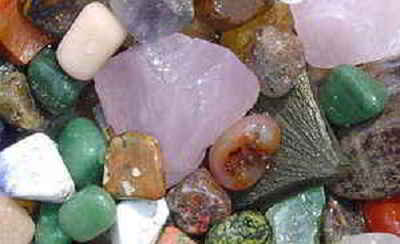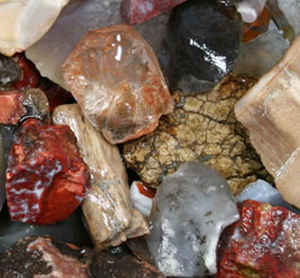
Utah Symbols
Utah State Rock
Coal

Adopted on March 13, 1991.
Coal was officially recognized as the State Rock on 13 March 1991. It was proposed by Representative Mike Dmitrich of Price as a result of a school project in Carbon County. Coal is a black or brown rock that can be ignited and burned to produce heat and electricity. Coalburning power plants supply about half of the electricity used in the United States and nearly two-thirds of that used throughout the world. Utah coal deposits are found primarily in Carbon and Emery Counties of Central Utah.
Utah State Rock: Coal

Coal originates as plant matter that accumulates up in wetlands and bogs. Coal begins to form when anaerobic bacteria break down plant material and convert it to peat through the removal of oxygen and hydrogen. The peat is then buried by sediment and more plant material, raising the temperature and pressure of the peat. As the peat compresses, water and methane gas are forced out, leaving an increasing proportion of carbon. With increasing heat and pressure the peat is converted successively into lignite, subbituminous coal, bituminous coal, and anthracite. Most of the coal mined in Utah is bituminous.
Coal is a black or brown rock that can be ignited and burned to produce heat energy. Coal-burning power plants supply about half of the electricity
used in the United States. Utah has eighteen recognized coal fields (in as many counties); they contain an estimated 39 billion tons of coal.
Coal is used during the coking process in steel production, and is burned in power plants to produce heat and electricity. Nearly all of Utah's coal
must be obtained from underground mines. The Book Cliffs, Wasatch Plateau and Kaiparowits coal fields are the three most important in the state. Most
Utah coal is of bituminous rank (soft coal) and relatively high in potential heat productions (BTUs). Coal is found in 17 of Utah's 29 counties, but
coal mining is primarily concentrated in Emery and Carbon Counties. Coal production in Utah during 1994 is estimated at 24 million
tons.
Coal is found in 17 of Utah's 29 counties but mainly concentrated in Emery and Carbon Counties.

Coal: One of the world's major sources of energy. In the United States, coal provides approximately 23% of all the energy consumed. Coal is used to produce more than half of all the electrical energy that is generated and used in the United States. Coal is a very complex and diverse energy resource that can vary greatly, even within the same deposit. In general, there are four basic varieties of coal, which are the result of geologic forces having altered plant material in different ways. These varieties descended from the first stage in the formation of coal: the creation of peat or partially decomposed plant material.
Lignite: Increased pressures and heat from overlying strata causes buried peat to dry and harden into lignite. Lignite is a brownish-black coal with generally high moisture and ash content and lower heating value. However, it is an important form of energy for generating electricity. Significant lignite mining operations are located in Texas, North Dakota, Louisiana, and Montana.
Subbituminous Coal: Under still more pressure, some lignite was changed into the next rank of coal subbituminous. This is a dull black coal with a higher heating value than lignite that is used primarily for generating electricity and for space heating. Most subbituminous reserves are located in Montana, Wyoming, Colorado, New Mexico, Washington and Alaska.
Bituminous Coal: Even greater pressure results in the creation of bituminous, or "soft"coal. This is the type most commonly used for electric power generation in the U.S. It has a higher heating value than either lignite or subbituminous, but less than that of anthracite. Bituminous coal is mined chiefly in Appalachia and the Midwest. Also used to make coke.
Anthracite: Sometimes also called "hard coal,"anthracite forms from bituminous coal when great pressures developed in folded rock strata during the creation of mountain ranges. This occurs only in limited geographic areas - primarily the Appalachian region of Pennsylvania. Anthracite has the highest energy content of all coals and is used for space heating and generating electricity.
Coal is a sedimentary rock of biochemical origin NOT Mineral
- Sedimentary Rock Type: Biochemical
- Related to: Shale, sandstone and limestone
- Color: Generally black to dark brown or gray
- Texture: Amorphous and glassy to coarse fragments
- Origins: Swampy environments
- Common Minerals: Graphite , pyrite and jet (a mineraloid)
- Uses: Source of energy, lubricant, pigment and source of carbon for industrial purposes
Utah Law
The law designating coal as the official Utah state rock is found in the Utah Statutes, Title 63, Chapter 13, Section 63-13-5.5 (22).
TITLE 63. State Affairs in General.
CHAPTER 13. Miscellaneous Provisions.
SECTION 63-13-5.5. State Symbols.
63-13-5.5. State symbols.
(1) Utah's state animal is the elk.
(2) Utah's state bird is the sea gull.
(3) Utah's state centennial astronomical symbol is the Beehive Cluster located in the constellation of Cancer the Crab.
(4) Utah's state centennial star is Dubhe, one of the seven bright stars composing the Big Dipper in the constellation Ursa Major.
(5) Utah's state centennial tartan, which honors the first Scots known to have been in Utah and those Utahns of Scottish heritage, shall have a pattern
or repeating-half-sett of white-2, blue-6, red-6, blue-4, red-6, green-18, red-6, and white-4 to represent the tartan worn anciently by the Logan and
Skene clans, with the addition of a white stripe.
(6) Utah's state cooking pot is the dutch oven.
(7) Utah's state emblem is the beehive.
(8) Utah's state fish is the Bonneville cutthroat trout.
(9) Utah's state flower is the sego lily.
(10) Utah's state folk dance is the square dance, the folk dance that is called, cued, or prompted to the dancers and includes squares, rounds, clogging,
contra, line, and heritage dances.
(11) Utah's state fossil is the Allosaurus.
(12) Utah's state fruit is the cherry.
(13) Utah's state vegetable is the Spanish sweet onion.
(14) Utah's historic state vegetable is the sugar beet.
(15) Utah's state gem is topaz, as is prominently found in the Thomas Mountain Range in Juab County, Utah.
(16) Utah's state grass is Indian rice grass.
(17) Utah's state hymn is "Utah We Love Thee" by Evan Stephens.
(18) Utah's state insect is the honeybee.
(19) Utah's state mineral is copper.
(20) Utah's state motto is "Industry."
(21) Utah's state railroad museum is Ogden Union Station.
(22) Utah's state rock is coal.
(23) Utah's state song is "Utah This is the Place" by Sam and Gary Francis.
(24) Utah's state tree is the blue spruce.
Minerals, & Gems

Gemstone, Minerals, Rocks






